Linux has come a long way from a command line interface to an intuitive and stunning graphical user interface. Today, all the Linux distros come with a beautiful desktop environment, easy-to-use interface, and user-friendly motto implementation in the core.
I rather just say that Linux does not only come with a nice-looking desktop manager but also it offers a wide range of useful and effective sets of free and open source software for completing all the basic and advanced needs.
I use one of the best and most popular Linux distros, Ubuntu. I always recommend that others use or at least try all the most popular Linux distros and get settled with anyone who shows promise and is best suited for that individual user.
Most Popular Linux Distros
Here today, I would like to suggest you use any of these Linux distros and be ready to be amazed by the huge set of features that a most popular Linux distro can offer.
5. Manjaro Linux
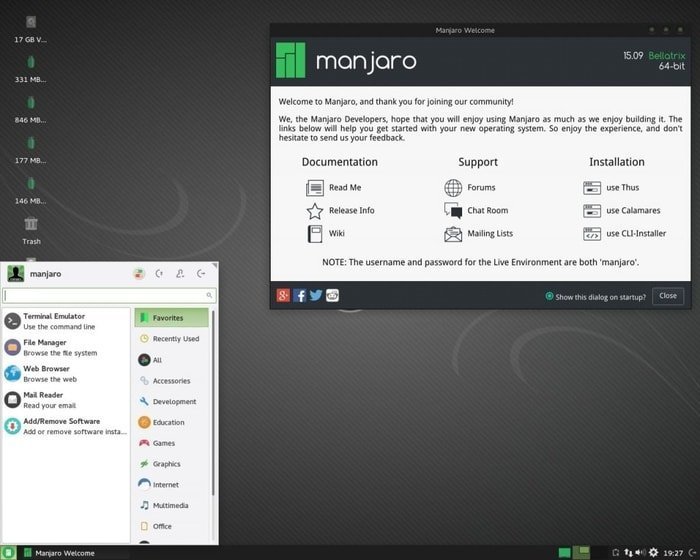
Manjaro is one of the best and most popular Linux distros based on Arch Linux. This Linux distro is best fitted and user-friendly for newcomers and advanced users. As it’s based on Arch Linux, it does support a total of three sets of software repositories, including Unstable, Testing, and Stable software repositories. Manjaro supports command line packages and GUI software installation – “Pacman.”
Recommend Read: Best Linux Gaming Distros: 7 Shortlisted Recommendations
Main Features
- It supports cutting-edge software and has a stable application base that is in line with Arch Linux.
- Comes in many flavors like KDE, Cinnamon, LXDE, MATE, LXQt, Gnome, Xfce, and much more.
- Offers a very easy and intuitive installation process.
- It comes with pre-installed packages, including multimedia codecs to enjoy audio and video.
- Extensive desktop configuration ability.
- You can install multiple kernels, and it offers a special bash script for managing graphics drivers.
4. OpenSUSE
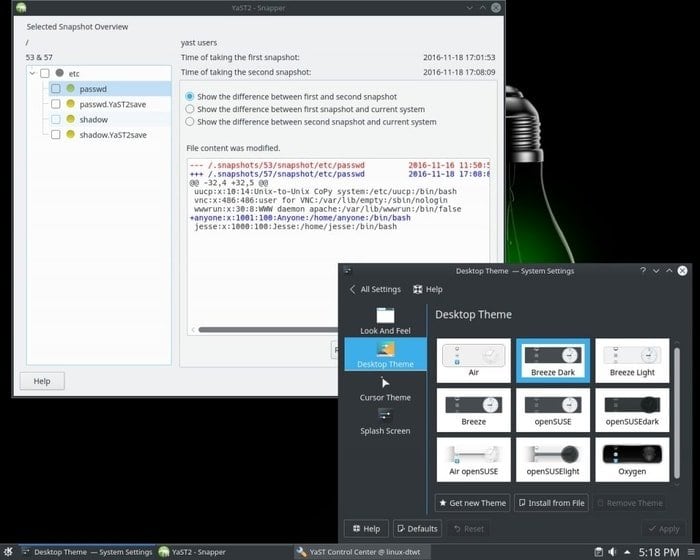
OpenSUSE is a community-sponsored one of the stable Linux distros made by SUSE Linux and other companies – Novell. After using the same code base in collaboration and sync with SUSE Linux Enterprise – SLE, it stops releasing the regular version rather than focusing on a stable and long life cycle. So, OpenSUSE code takes all the good features from SUSE Linux Enterprise and vice versa.
Main Features
- OpenSUSE has a total of three main goals – make OpenSUSE the easiest and most widely used Linux Distro; make OpenSUSE the most usable desktop environment for newbie and experienced users based on open-sourced collaboration; make OpenSUSE simple, easy, and the best choice for development and packaging processes to Linux developers and software vendors.
- Comes with a lot of variations, including Cinnamon, GNOME, IceWM, KDE, LXDE, Openbox, WMaker, and Xfce.
- It does not focus on regular release but on rolling for a long-term cycle and cutting-edge stable features.
3. Ubuntu Linux
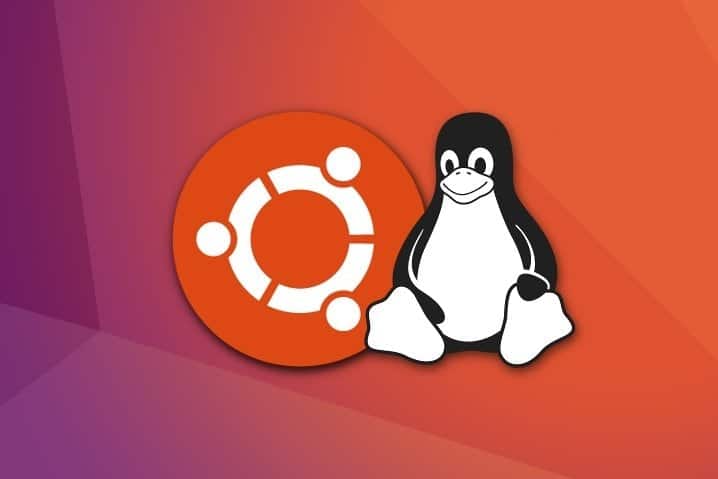
Ubuntu is one of the most popular, stable, and best-fitted for newcomers to Debian-based Linux distro. It has its software repositories, which are regularly synced with the Debian repository so that all the applications get stable and the latest release.
Ubuntu was developed by Canonical, and this company has devoted a great effort to making Ubuntu popular and well-known in the Linux community, which now greatly supports a wide range of devices, including smartphones, tablets, PCs, servers, and cloud VPS.
Recommended Read: Top 5 Best Looking Linux Distro We Recommend You To Use
Main Features
- This Linux Distro is a rock-solid, stable, and secure OS.
- Ubuntu comes with various desktop environments like Gnome, KDE, XFCE, MATE, etc.
- Though Ubuntu is based on Debian, it’s also the foundation for Linux Mint, Elementary OS, Kubuntu, Lubuntu, Deepin, and much more.
- Users can try all the core features before installing the full Ubuntu desktop using the installation image.
- Best and Most user-friendly for new users on Linux who do not know Gnome from bash.
- Many essential apps come pre-installed, and the user can install all the necessary software from the official apps repository.
- It’s one of the best customizable Linux distros for the advanced users.
- Ubuntu comes with one of the best, smoothest, most modern, and unique desktop environments, “ Gnome.”
- Each after six months, it offers new releases, and every two years, it releases a Long Term Support (LTS).
2. Debian
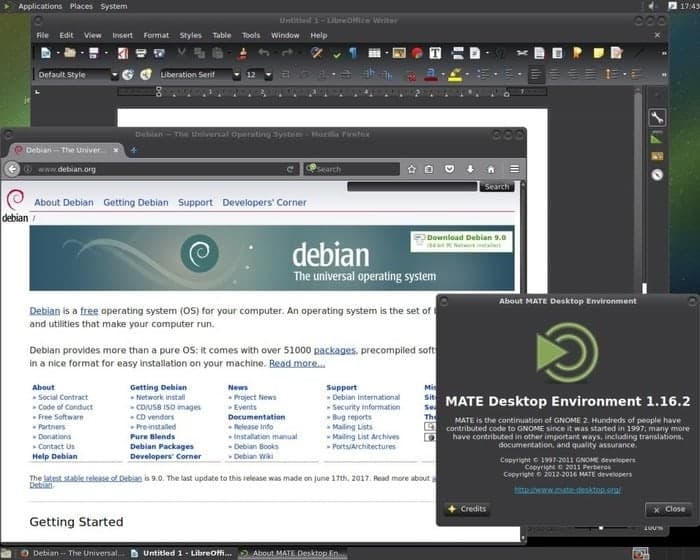
Debian is the most stable Linux distro, with the motto of free OS and a huge set of free software for everyone. Debian does not focus on new releases frequently, like Ubuntu and Linux Mint, but its prime focus is on super stable releases. For that reason, Debian releases a stable version every two years. Debian is a grandfather distro used to make many popular and effective distros, including Ubuntu, Linux Mint, Deepin, Elementary OS, etc.
Main Features
- Debian always comes with a super stable version, which is thoroughly tested and bug-fixed.
- More than 50000 stable and free software is there in the Debian repositories.
- Literally, a user can find effective and useful applications in the Debian software repository, which is completely free.
- It comes with all the desktop flavors that a user can imagine, like AfterStep, Awesome, Black Box, Cinnamon, Fluxbox, flwm, FVWM, GNOME, i3, IceWM, ion, JWM, KDE, LXDE, MATE, Openbox, pekwm, Ratpoison, LXQt, WMaker, XBMC, Xfce.
1. Linux Mint
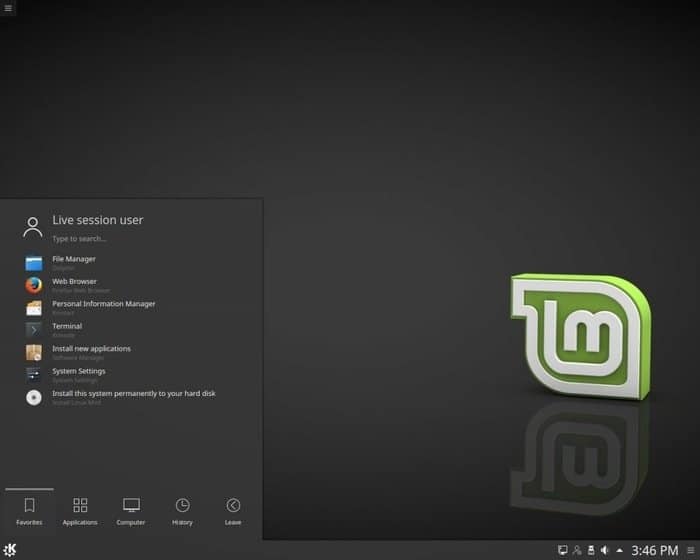
Linux Mint is the #1 most popular and best user-friendly Ubuntu-based Linux distro available out there. Linux Mint is a similarly perfect fit for both newcomers and advanced users. The main motto of Linux Mint is “From freedom came elegance,” which provides a stable, powerful, easy-to-use, and complete out-of-the-box experience.
Main Features
- As Linux Mint is a Ubuntu-based Linux distro, it will be fully compatible with Ubuntu software repositories.
- Comes with a full-packed system including browser plugins, media codecs, support for DVD playback, Java, and other components.
- Linux Mint comes with a set of different flavors, as per user need, including Cinnamon, MATE, Cinnamon Edition – “EDGE,” and Xfce.
- Its installation process is super easy for any newbies to go ahead.
- If you like Mac OS, then you must definitely go for the Linux Mint Cinnamon desktop environment, which is super stable and looks elegant.
Honorable Mention
Some Honorable Mentions of the Most Popular Linux Distros are given below:
- Zorin OS
- MX Linux
- Elementary OS
- Arch Linux
- Fedora Linux
Final Thought
Linux is not only a name for versatile OS. Rather, it offers a complete and full-featured set of desktop environments where everything is free, open source, and community-driven. Lots of community members are always ready to help you out with any Linux problem.
Which one did you like from the above list of most popular Linux distros? Did you try all or just one? Share your Linux experiences and suggestions with the other users in the comment below. Share this article with your friends and family through social media and spread Linux love.

Beginners should use the following in this order:
– Fedora 33 Gnome (the normal .iso File)
– Pop!_OS 20.10
– Ubuntu 20.10
Advances users can use debian and gentoo. Why is gentoo on this list and not Fedora? Fedora is one of the simplest distributions to install, use and customize. Gentoo is a PITA to install. I would definitely NOT recommend gentoo for beginners and it’s also not one of the most popular distros! Fedora is much, much more popular!
I just installed Ubuntu on a 2011 iMac and love it! To me, it is better than Windows or Apple. If you are trying to decide if you should switch to Linux, I would say “do it!”. It was easy to install on iMac, windows may be harder but I intend to try today. Love Linux.
Fedora is easy to install, learn, and use. Why is it not up there? There was a meeting were someone said ” let’s put Gentoo and Depian on the list,” but not Fedora? Fedora is much easier to install than Debian, and I dare say that it is easier to find the right ISO as well. The process of installing Debian is punishment for shoplifting in some countries, why is it up there? I love the distros on this list and those that helped make them happen, but no Fedora? Why?
Redhat is their Debian, and redhat is the department of defence distro of choice, and Fedora is solid. It is not themed, but every “After installing…” list says to change and custumize that on every distro.
This was suppsed to be a reply to Leslie Satenstein. Looks like I didn’t hit the right ‘reply’ button
Zorin OS, Elementary OS, Linux Mint are based off of Ubuntu. Ubuntu itself is based on Debian.
Therefore, it’s fair to say that Debian more or less occupies 5 of these 8 spots with OpenSUSE, Gentoo Linus and Manjaro Linux being the exceptions.
Of course Raspbian, which powers the Raspberry Pi Microcontrollers is also based on Debian.
zorin is ubuntu with eye candy
Zorin is soo good, I know it focuses on newbie but its so good. Like it has all necessary software included like Gimp, Libre Office, and AppStore and one click driver update.
It also has Wine in built.
And its themes engine is awesome too. So simple yet so powerful
You just install and every thing is already there. No bullshiting around with Gnome extension for customization and no error while setting up wine.
Nice to see that Mint is in first place. It’s by far the most convenient distribution, everything marvelously self-explanetory, free of all that entanglement and clumsiness that’s so typical for so many other distributions. And although the old motto “From freedom came elegance” has disappeared, it’s still the aesthetically most pleasing one. The best thing, however, is that Mint doesn’t patronize its users – contrary to elemenatry or Zorin, for instance. I’d say that’s no wonder as there is French savoir vivre behind it. Try to find that anywhere else in the world or in any other distribution, and you’ll fail miserably. :-))
Here, here. I heartily agree!!
Personally I don’t really care which Linux distro I use.
What I do care about is the Desktop: and having fiddled around for about 18 years with all sorts
of stuff I will always go for XFCE.
How on earth XFCE is better than Cinnamon?!
Because Cinnamon derived from Gnome3. To big too slow.. etc..
Cannot be compared with a lightweight and fast XFCE 😉
Manjaro actual XFCE style is one the nicest. A always try to set same theme and outlook for all Arch, Gentoo and Debian installs.
I think Linux Mint is not good enough. I don’t like the icons or any of the themes it has, the graphics looks so low quality. Why are all the icons so lame?
Because you are not getting use to the icon of linux mint.
i think back box is one of the best
Linux Mint is pretty awesome. I have LMDE3 installed with Deepin 15.7 in a dual-boot configuration. They are both really great. KDE Neon is another that deserved mention. Plasma has become one of the finest desktop environments there is.
The KDE development team is on a tear as of late. Plasma is not only beautiful and stable but fast as lightning. It is using less than 600 MB RAM once booted. Deepin 15.7 is managing similar numbers.
The Linux desktop is undergoing an amazing evolution and it will only get better. There are so many phenomenal distributions that it almost isn’t fair to not write about them all.
Congratulations for this article for newbies, BUT
The popularity order – installs – is; Ubuntu(s), Arch – including Antergos and others with GUI installers -, Mint, Manjaro, and then, and far the others: Debian, Fedora – RHEL – CentOS, that is more popular than OpenSUSE – SUSE Gentoos – Sabayon – etc
And about Main features, in Manjaro – that is what I use – I would put:
1.- Let you choose proprietary drivers in Live mode, and to install them from the OS installer instead of after install
2.- GUI for kernel updates with rt kernels available – as UKUU with ppa install in Ubuntus –
3.- Almost one version for every desktop environment – with the only lack of Studio Pantheon – there was one – and Trinity spins at this moment, but you can install them from the Architect installer
4.- Calamares installer shared with the community is faster and easier than others
5.- It lets you configure and setup all to your likes
6.- The better XFCE distribution
Warnings:
1.- You have to edit grub.cfg if you boot from the grub in other OS because it uses 2 images to boot and the other grubs only detect one that would give you kernel panic error.
2.- You cannot have 2 disks with Manjaro EFI boot system, but you can have one from other distribution and one from Manjaro
“All the above most popular Linux distro is sorted out based on daily hits and downloads from the DistroWatch.”
a) Distrowatch is no measure of how popular a distro is.
b) Distrowatch does not appear to have a download facility
c) Distrowatch changes with time. At the moment Antergos is 5 and Manjaro is 6.
Thanks very nice blog!
I used Fedora. It is a great but weakly crippled distribution. By crippled, I weakly mean that the necessary software to make it first in your list is not allowed. It is partly through observation of Licensing rules, policies that block extra software that does not meet FOSS GPL2 rules.
However, there are three distributions that are built, using Fedora xx as the base. In C++ terms I call those Fedora++ They are, in alphabetical order, Chapeaulinux, Kororaproject, and Russian Fedora Linux (RFRlinux)
The latter three add in software for skype, dropbox, grub2-guis, full vlc support, Steam for gamers, beautiful background images. Each of these Remixes in their own way, glue the extras to Fedora xx and present a fully tested ISO for the user to install. The extras, along with Fedora, provide the desktop that is better than comparable to the Distrowatch’s top five list.
I have this comment about Top 5. Many users download distributions. Not many users install them. The way that Fedora measures users is by counting the number of systems that connect to download patches. And their counting includes the mentioned Remixes
Not sure how old this post is, but I noticed that the alternatives you pointed out are defunct at this point. Chapeau called it quits back in February of 18 (2+ years as of this reply), Korora’s website actually redirects to Fedora. They are both marked “Discontinued” on Distrowatch. I can’t really find much on the other one you mentioned (Russian Fedora). I’m not sure when your reply was, maybe I’m just resurrecting an old thread, but thought I’d mention it. ?
Linux Mint Cinnamon is my Favorite.
I personally also like Linux Mint. This distro is really useful and user-friendly for a newbie, especially who comes from windows or mac OS.